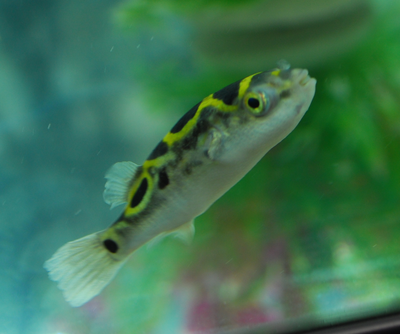Figure 8 Pufferfish
Posted by Max Gandara on on 14th May 2025
Figure 8 Pufferfish: The Spotted Clown of the Brackish World
Small, colorful, and full of curiosity, the Figure 8 Pufferfish (Dichotomyctere ocellatus) is one of the most popular puffers in the aquarium trade. Known for its vibrant yellow-green back, figure-8-shaped spots, and endlessly watchful eyes, this puffer is a bold, intelligent species that brings life to any aquarium.
But don’t be fooled by its manageable size and cartoonish looks—like all puffers, the Figure 8 demands special care, especially when it comes to water chemistry and tank mates.
What is a Figure 8 Puffer?
Native to brackish estuaries and coastal rivers of Southeast Asia, the Figure 8 Puffer grows to a maximum of 3 inches (7–8 cm), making it smaller than the Green Spotted Puffer but just as full of attitude.
Key Features:
-
Scientific name: Dichotomyctere ocellatus
-
Size: Up to 3 inches
-
Lifespan: 8–10 years
-
Tank level: Midwater swimmer
-
Salinity: Low-end brackish water (SG 1.005–1.008)
The Figure 8 gets its name from the distinctive pattern on its back, which often resembles the number eight or infinity symbol.
Freshwater or Brackish?
This is a common question—and a crucial one.
The answer: brackish water is required long-term.
Juveniles are sometimes sold as freshwater fish, but adult Figure 8 Puffers need a salinity level of about SG 1.005–1.008 for long-term health and to prevent disease. Use marine salt mix (not aquarium salt) and a refractometer to measure salinity accurately.
Tank Setup & Environment
Though small, Figure 8 Puffers are active, curious, and territorial, so tank setup matters a lot.
Minimum Tank Size:
-
20–30 gallons for one puffer
-
Add 10–15 gallons for each additional puffer
Environment:
-
Substrate: Fine sand or gravel
-
Décor: Driftwood, caves, and plants (plastic or hardy brackish-tolerant types like Anubias or java fern)
-
Lighting: Moderate
-
Filtration: Strong biological filtration; puffers are messy eaters
Perform weekly 30–50% water changes to keep the system clean and parameters stable.
Water Parameters:
-
Temperature: 75–80°F (24–27°C)
-
pH: 7.5–8.3
-
Salinity: SG 1.005–1.008
-
Ammonia/Nitrite: 0 ppm
Diet: The Crunch Factor
Puffers have constantly growing teeth (beaks) that must be worn down through their diet. Soft foods will lead to overgrown teeth, which may require trimming.
Ideal Foods:
-
Snails (crucial for dental health)
-
Crustaceans: Crabs, shrimp (in shell)
-
Mussels, clams, or cockles
-
Occasional treats: Bloodworms, blackworms, krill
Feed 5–6 days a week, and skip a day to help with digestion.
Behavior and Tank Mates
The Figure 8 Puffer is intelligent, interactive, and territorial. It may recognize its keeper and will often follow you along the glass.
But when it comes to tank mates—caution is key.
Tank Mate Guidelines:
-
Best in a species-only tank
-
If mixing, consider fast, tough, brackish fish like:
-
Mollies
-
Knight gobies
-
Bumblebee gobies
-
Scats (in very large tanks only)
-
Avoid:
-
Long-finned fish (they nip)
-
Shrimp and snails (they eat them)
-
Slow or peaceful species
Each puffer has a distinct personality—some tolerate tank mates better than others, but there's always risk of aggression.
Health and Common Issues
Figure 8 Puffers are relatively hardy when kept in proper brackish conditions but can suffer in poor setups.
Watch for:
-
Internal parasites (common in wild-caught puffers)
-
Fungal or bacterial infections in freshwater setups
-
Overgrown beak/teeth from soft diets
-
Puffing up—rare, but a sign of extreme stress (or sometimes defense)
Always quarantine new puffers and consider deworming upon arrival with praziquantel or similar treatments.
Fun Facts
-
Eyes move independently, giving them a wide field of vision.
-
Puffers can inflate their bodies with water (or air), but this should be avoided in captivity.
-
They exhibit complex behavior—curious, trainable, and even playful at times.
Final Thoughts
The Figure 8 Pufferfish is a small fish with a big personality. It’s perfect for aquarists who want an interactive, intelligent pet—but it’s not for those seeking a low-maintenance community fish.
With the right tank, brackish water, a crunchy diet, and some patience, a Figure 8 Puffer will reward you with years of charm, curiosity, and cheeky behavior.
Pro Tip: Want more puffer action? Compare the Figure 8 with the Dwarf Puffer or Green Spotted Puffer to find your perfect aquatic match.

